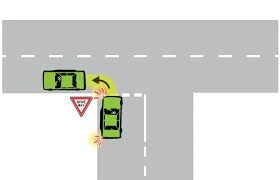Left turns are fundamental driving movements and play a key role in navigating intersections, changing lanes and reaching different destinations.
Although making a left turn seems simple, it requires a nuanced understanding of traffic dynamics, correct direction rules and spatial awareness.
In this report, we discuss the complications of left-turning, the importance of proper instructions, following the rules of the road, the challenges of left-turning and the role of technology to increase safety during these maneuvers.
Challenges of left turns
Signaling and Communication
Proper signaling is the cornerstone of safe and effective left turns. Communicating clear intentions to other road users ensures predictable traffic flow, reducing the likelihood of misunderstandings and potential accidents. Drivers approaching an intersection where they intend to turn left must activate their turn signals in time and be aware of surrounding vehicles and pedestrians. The ability to signal effectively reflects a commitment to responsible communication on the road that promotes a safer driving environment.
Compliance with traffic rules:
Special traffic rules apply to left turns, especially the rules regarding headlights and traffic lights. Understanding the right-of-way rules at intersections is crucial to making safe left turns. When necessary, drivers must yield to oncoming traffic and pedestrians and proceed through the intersection in accordance with local traffic regulations. Paying attention to traffic lights, including green arrows and dedicated left lanes, ensures timely left turns, reducing the risk of collisions.
Challenges and Safety Considerations:
Left turns, especially at busy or complex intersections, present their own challenges that require special attention. Estimating oncoming traffic, measuring the speed and distance of approaching vehicles, and considering potential blind spots require acute situational awareness. The need to navigate these challenges without disrupting traffic flow or compromising safety underscores the complexity of left turns. Drivers must exercise caution and make strategic decisions to deal with the nuances of left turns in various road scenarios.
Safety Technology Integration: Advances in Driver Assistance Systems
Developments in driver assistance systems have revolutionized automotive safety and ushered in a new era of enhanced driving experiences. These systems use state-of-the-art technology to provide real-time assistance and support to drivers, making a significant contribution to overall road safety. Features such as adaptive cruise control, lane departure warning and collision avoidance systems use sensors, cameras and radar to monitor the vehicle and its surroundings. By analyzing data in real time, these systems can warn drivers of potential dangers, help maintain a safe distance from other vehicles and even intervene to prevent collisions.
In addition, the integration of driver assistance systems includes parking radar, blind spot monitoring and an advanced cross-traffic assistant, which provides comprehensive support in various driving situations. As these technologies evolve, the automotive industry is witnessing a paradigm shift towards vehicles equipped with intelligent systems that not only improve driver safety but also pave the way for the further development of autonomous driving. The continuous development of these systems promises a safer, more efficient and technically advanced driving environment for drivers worldwide.

In the era of technological innovation, driver assistance systems (DAS) play an important role in improving safety during left turns. Advanced features such as blind spot monitoring, collision avoidance systems and cross-traffic assistance help reduce the risks associated with left turns. These technological advances provide drivers with real-time information, alerting them to potential threats and helping them make decisions. Integrating technology into driving practices improves overall left-turn safety and adds an extra layer of protection to the road.
Conclusion: Left Turns as Strategic Driving
In summary, mastering left turns while driving involves a multifaceted approach that includes clear signage, obeying the rules of the road, meeting the challenges of complex intersections and using advanced technology. Left turns are not just a routine move but a strategic driving skill that requires communication, awareness and responsible decision-making. Although the roads continue to evolve, the ability to make a left turn remains the hallmark of a professional and safety-conscious driver.
Left turns become particularly difficult at complex intersections where many factors are involved. Assessing oncoming traffic, estimating the speed and distance of approaching vehicles, and considering potential blind spots require strategic decision-making. Negotiating fast or difficult intersections requires a combination of vigilance, patience and proactive planning. Drivers must skillfully navigate these challenges to safely make left turns, demonstrating their strategic skills in a variety of driving environments.
.
